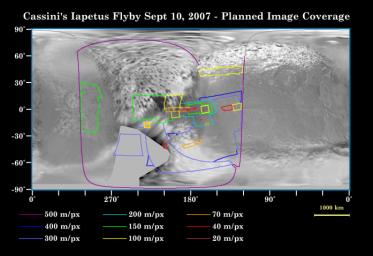
|
Eyes on Iapetus!
- Click the image above for a larger view
- Full-Res JPEG (1180 x 809) (119.5 kB)
- Full-Res TIFF (1180 x 809) (2.9 MB)
Caption:
This map of the surface of Iapetus, generated from images taken by NASA's Cassini and Voyager spacecraft, illustrates the imaging coverage planned for Cassini's very close flyby of the two-toned moon on Sept. 10, 2007. This flyby will be Cassini's only close approach to Iapetus (1,468 kilometers, or 912 miles across) during the entire planned mission.
At closest approach, Cassini will be 1,640 kilometers (1,020 miles) above the surface of Iapetus. The spacecraft will pass the moon at a speed of about 2.4 kilometers (1.5 miles) per second--a relatively leisurely pace that will allow plenty of time for the scientific instruments on board to collect massive amounts of data.
Cassini's previous encounter with Iapetus, on Dec. 31, 2004, focused on the mysterious territory in Cassini Regio, the region blanketed by dark material that covers most of the moon's leading hemisphere. The upcoming encounter will be primarily concerned with terrain farther west, in the important transition region between Cassini Regio and the bright trailing hemisphere. Scientists hope to learn a great deal more about the composition of the materials that compose the surface of Iapetus during this encounter.
Another area of focus is the large equatorial ridge that overlies the moon's equator (see PIA06166 ). The ridge reaches 20 kilometers (12 miles) high in some places and extends over 1,300 kilometers (808 miles) in length. No other moon in the solar system has a geological feature like this striking ridge. The tallest mountains on the ridge rival Olympus Mons on Mars, which is approximately three times the height of Mt. Everest. Such giant mountains are a surprising feature for such a small body as Iapetus, which is nearly five times smaller than Mars and nearly nine times smaller than Earth.
Colored lines on the map enclose regions that will be covered at different imaging scales as Cassini encounters Iapetus. The highest expected resolution of Cassini images from this flyby is about 20 meters (65 feet) per pixel--significantly higher than the 2004 encounter.
Background Info:
The Cassini-Huygens mission is a cooperative project of NASA, the European Space Agency and the Italian Space Agency. The Jet Propulsion Laboratory, a division of the California Institute of Technology in Pasadena, manages the mission for NASA's Science Mission Directorate, Washington, D.C. The Cassini orbiter and its two onboard cameras were designed, developed and assembled at JPL. The imaging operations center is based at the Space Science Institute in Boulder, Colo.
For more information about the Cassini-Huygens mission visit http://saturn.jpl.nasa.gov/home/index.cfm . The Cassini imaging team homepage is at http://ciclops.org .
Cataloging Keywords:
| Name | Value | Additional Values |
|---|---|---|
| Target | Iapetus | Mars |
| System | Saturn | |
| Target Type | Satellite | Planet |
| Mission | Cassini-Huygens | Voyager |
| Instrument Host | Cassini Orbiter | |
| Host Type | Orbiter | Flyby Spacecraft |
| Instrument | Imaging Science Subsystem (ISS) | |
| Detector | ||
| Extra Keywords | Color, Map, Mountain | |
| Acquisition Date | ||
| Release Date | 2007-09-05 | |
| Date in Caption | 2004-12-31 | |
| Image Credit | NASA/JPL/Space Science Institute | |
| Source | photojournal.jpl.nasa.gov/catalog/PIA08371 | |
| Identifier | PIA08371 | |
